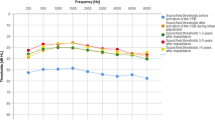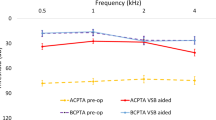Abstract
In this study, we aimed to compare the outcomes of satisfaction of the patients who used hearing aids preceding the vibrant sound bridge (VSB) application on middle ear windows (14 oval window and 5 round window). Nineteen adult patients with conductive or mixed hearing loss were included in the study. All patients used behind the ear hearing aids on the site which was selected for VSB application. The patients used hearing aids for at least 3 months before the VSB operation. The floating mass transducer (FMT) was placed on one of the middle ear windows (oval or round) in VSB operation. The patients were evaluated with International Outcome Inventory for Hearing Aids (IOI-HA) preoperatively after at least 3 months trial of conventional hearing aid and postoperatively after 3 months use of VSB. No perioperative problem was encountered. The total score of IOI-HA was significantly higher with VSB compared with conventional hearing aids (p < 0.05). No statistically significant difference was found between the daily use, residual activity limitations, satisfaction, impact on others, quality of life between middle ear implant and hearing aid (p > 0.05). The IOI-HA scores were significantly higher with the middle ear implant than the conventional hearing aid regarding benefit and residual participation restrictions (p < 0.05). Although the scores for quality of life assessment was similar between VSB and hearing aid use, there was a superiority of VSB in terms of benefit and residual participation restrictions as well as overall IOI-HA scores as the FMT was placed on one of the middle ear windows.
Similar content being viewed by others
References
Kochkin S, MarkeTrack III (1992) Higher hearing aid sales don’t signal better market penetration. Hear Journal 45:47–54
Kim HH, Barrs DM (2006) Hearing aids: a review of what’s new. Otolaryngol Head Neck Surg 134:1043–1050
Counter P (2008) Implantable hearing aids. J Eng Med 222:837–852
Backous DD, Duke W (2006) Implantable middle ear hearing devices: current state of technology and market challenges. Curr opin Otolaryngol Head Neck Surg 14:314–318
Beltrame AM, Martini A, Prosser S, Giarbini N, Streitberger C (2009) Coupling the vibrant soundbridge to cochlea round window: auditory results in patients with mixed hearing loss. Otol Neurotol 30:194–201
Colletti V, Soli SD, Carner M, Colletti L (2006) Treatment of mixed hearing losses via implantation of a vibratory transducer on the round window. Int Audiol 45(10):600–608
Geoffrey RB (2010) The vibrant soundbridge: design and development. Adv Otorhinolaryngol 69:1–13
Mosnier I, Sterkers O, Bouccara D, Labassi S, Bebear JP, Bordure P et al (2008) Benefit of the vibrant soundbridge device in patients implanted for 5 to 8 years. Ear Hear 29:281–284
Wagner F, Todt I, Wagner J, Ernst A (2010) Indications and candidacy for active middle ear implants. Adv Otorhinolaryngol 69:20–26
Sterkers O, Boucarra D, Labassi S, Bebear JP, Dubreuil C, Frachet B et al (2003) A middle ear implant, the symphonix vibrant soundbridge: retrospective study of the first 125 patients implanted in France. Otol Neurotol 24:427–436
Todt I, Seidl RO, Ernst A (2005) Hearing benefit of patients after vibrant soundbridge implantation. ORL J Otorhinolaryngol Relat Spec 67:203–206
Deveze A, Rameh C, Sanjuan M, Lavieille JP, Magnan J (2010) A middle ear implant with a titanium canal wall prosthesis for a case of an open mastoid cavity. Auris Nasus Larynx 37(5):631–635
Truy E, Philibert B, Vesson JF, Labassi S, Collet L (2008) Vibrant soundbridge versus conventional hearing aid in sensorineural high-frequency hearing loss: a prospective study. Otol Neurotol 29(5):684–687
Boeheim K, Pok SM, Schloegel M, Filzmoser P (2010) Active middle ear implant compared with open-fit hearing aid in sloping high-frequency sensorineural hearing loss. Otol Neurotol 31(3):424–429
Uziel A, Mondain M, Hagen P, Dejean F, Doucet G (2003) Rehabilitation for high-frequency sensorineural hearing impairment in adults with the symphonix vibrant soundbridge: a comparative study. Otol Neurotol 24(5):775–783
Kiefer J, Arnold W, Staudenmaier R (2006) Round window stimulation with an implantable hearing aid (soundbridge) combined with autogenous reconstruction of the auricle—a new approach. ORL J Otorhinolaryngol Relat Spec 68(6):378–385
Hüttenbrink KB, Zahnert T, Bornitz M, Beutner D (2008) TORP-vibroplasty: a new alternative for the chronically disabled middle ear. Otol Neurotol 29(7):965–971
Hol MK, Snik AF, Mylanus EA, Cremers CW (2005) Long-term results of bone-anchored hearing aid recipients who had previously used air-conduction hearing aids. Arch Otolaryngol Head Neck Surg 131(4):321–325
Verhaegen VJ, Mulder JJ, Cremers CW, Snik AF (2012) Application of active middle ear implants in patients with severe mixed hearing loss. Otol Neurotol 33(3):297–301
Todt I, Seidl RO, Gross M, Ernst A (2002) Comparision of different vibrant soundbridge audioprocessors with conventional hearing aids. Otol Neurotol 23:669–673
Schmuziger N, Schimmann F, àWengen D, Patscheke J, Probst R (2006) Long-term assessment after implantation of the vibrant soundbridge device. Otol Neurotol 27:183–188
Fraysse B, Lavieille JP, Schmerber S, Enée V, Truy E, Vincent C, Vaneecloo FM, Sterkers O (2001) A multicenter study of the vibrant soundbridge middle ear implant: early clinical results and experience. Otol Neurotol 22(6):952–961
Baumgartner WD, Böheim K, Hagen R, Müller J, Lenarz T, Reiss S et al (2010) The vibrant soundbridge for conductive and mixed hearing losses: european multicenter study results. Adv Otorhinolaryngol 69:38–50
Author information
Authors and Affiliations
Corresponding author
Rights and permissions
About this article
Cite this article
Atas, A., Tutar, H., Gunduz, B. et al. Vibrant sound bridge application to middle ear windows versus conventional hearing aids: a comparative study based on international outcome inventory for hearing aids. Eur Arch Otorhinolaryngol 271, 35–40 (2014). https://doi.org/10.1007/s00405-013-2387-2
Received:
Accepted:
Published:
Issue Date:
DOI: https://doi.org/10.1007/s00405-013-2387-2




